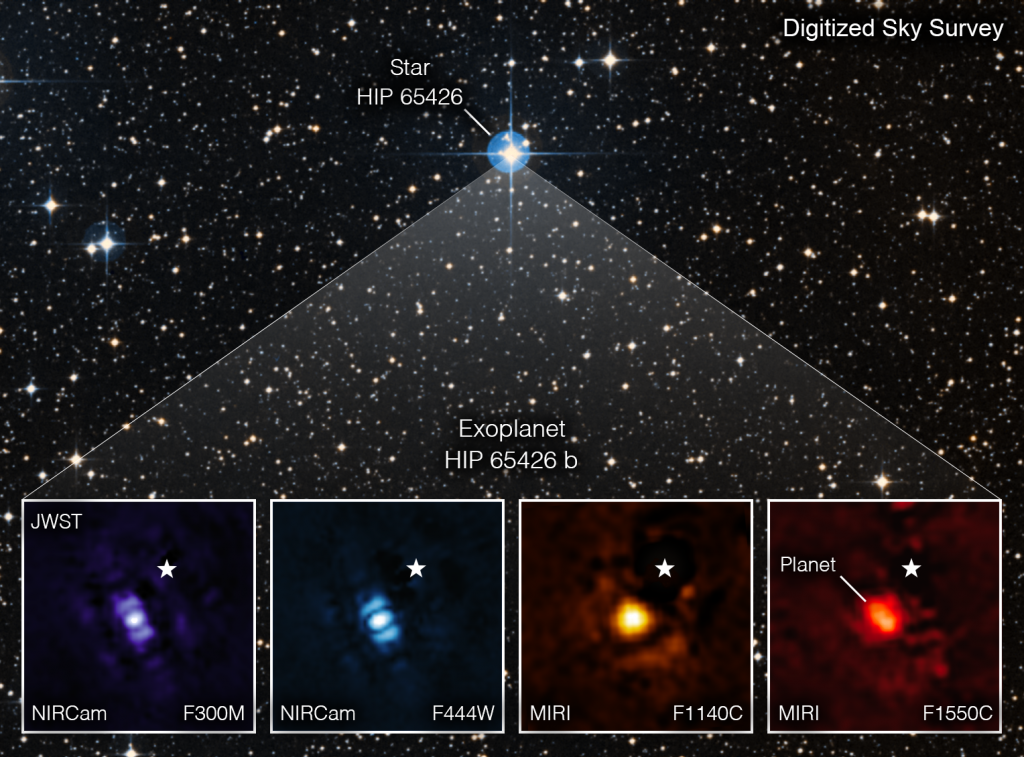To capture a direct image of a planet outside the solar system, NASA’s James Webb Space Telescope has been used by astronomers for the first time. Without any rocky surface and being habitable, the exoplanet is a gas giant.
 This image shows the exoplanet HIP 65426 b in different bands of infrared light, as seen from the James Webb Space Telescope: purple shows the NIRCam instrument’s view at 3.00 micrometers, blue shows the NIRCam instrument’s view at 4.44 micrometers, yellow shows the MIRI instrument’s view at 11.4 micrometers, and red shows the MIRI instrument’s view at 15.5 micrometers. These images look different because of the ways the different Webb instruments capture light. A set of masks within each instrument, called a coronagraph, blocks out the host star’s light so that the planet can be seen. The small white star in each image marks the location of the host star HIP 65426, which has been subtracted using the coronagraphs and image processing. The bar shapes in the NIRCam images are artifacts of the telescope’s optics, not objects in the scene. (Unlabeled version.) Image Credit: NASA/ESA/CSA, A Carter (UCSC), the ERS 1386 team, and A. Pagan (STScI).
This image shows the exoplanet HIP 65426 b in different bands of infrared light, as seen from the James Webb Space Telescope: purple shows the NIRCam instrument’s view at 3.00 micrometers, blue shows the NIRCam instrument’s view at 4.44 micrometers, yellow shows the MIRI instrument’s view at 11.4 micrometers, and red shows the MIRI instrument’s view at 15.5 micrometers. These images look different because of the ways the different Webb instruments capture light. A set of masks within each instrument, called a coronagraph, blocks out the host star’s light so that the planet can be seen. The small white star in each image marks the location of the host star HIP 65426, which has been subtracted using the coronagraphs and image processing. The bar shapes in the NIRCam images are artifacts of the telescope’s optics, not objects in the scene. (Unlabeled version.) Image Credit: NASA/ESA/CSA, A Carter (UCSC), the ERS 1386 team, and A. Pagan (STScI).
By observing via four different light filters, the image shows how Webb’s efficient infrared gaze can seamlessly capture planets beyond the solar system, which points the way to future observations that unleash more data about exoplanets than ever before.
This is a transformative moment, not only for Webb but also for astronomy generally."
Sasha Hinkley, Associate Professor, Physics and Astronomy, University of Exeter
Hinkley headed these observations with a huge global association. Webb is a global mission headed by NASA in association with its partners, European Space Agency (ESA) and Canadian Space Agency (CSA).
HIP 65426 b, the exoplanet in Webb’s image, is around 6 to 12 times the weight of Jupiter, and these observations can aid in narrowing that down even more. Compared to the 4.5-billion-year-old Earth, it is young as planets go—around 15 to 20 million years old.
In 2017, with the use of SPHERE instrument on the European Southern Observatory’s Very Large Telescope in Chile, astronomers found the planet and captured photos of it with short infrared wavelengths of light. At longer infrared wavelengths, Webb’s view unleashes new information that might not have been detected through ground-based telescopes due to the intrinsic infrared glow of Earth’s atmosphere.
The information from these observations is being analyzed by scientists, and a paper is being prepared to be submitted to journals for peer review. However, Webb’s first shot of an exoplanet already indicates the upcoming potential to study distant worlds.
As HIP 65426 b is around 100 times distant from its host star when compared to the Earth’s distance from the Sun, it is considerably farther from the star that Webb can find the planet separate from the star in the image easily.
Webb’s Near-Infrared Camera (NIRCam) and Mid-Infrared Instrument (MIRI) are both furnished with coronagraphs—tiny masks sets that stop starlight—enabling Webb to capture direct photos of particular exoplanets such as this. Nancy Grace Roman Space Telescope of NASA, which will be launched in a few years, will show a further advanced coronagraph.
“It was really impressive how well the Webb coronagraphs worked to suppress the light of the host star,” Hinkley stated.
Since stars are very much brighter than planets, capturing direct images of exoplanets is difficult. The HIP 65426 b planet is a few thousand times fainter than its host star in the mid-infrared and more than 10,000 times fainter in the near-infrared.
The planet looks like a blob of light that is somewhat differently shaped in each filter image. This is due to Webb’s optical system’s particulars and how it translates light via various optics.
Obtaining this image felt like digging for space treasure. At first all I could see was light from the star, but with careful image processing I was able to remove that light and uncover the planet.
Aarynn Carter, Postdoctoral Researcher, University of California
Aarynn Carter headed the analysis of the images.
As the Hubble Space Telescope has taken direct images of exoplanets earlier, this is not the first direct image of an exoplanet captured from space. However, HIP 65426 b indicates the way ahead for the exploration of Webb’s exoplanet.
I think what’s most exciting is that we’ve only just begun. There are many more images of exoplanets to come that will shape our overall understanding of their physics, chemistry, and formation. We may even discover previously unknown planets, too.
Aarynn Carter, Postdoctoral Researcher, University of California